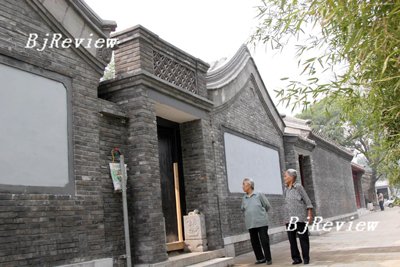
On the corner of a dusty Beijing hutong stands the shell of a half-renovated house. It has no roof, garden or pool, and was, until recently, equipped with a bare minimum of modern amenities. Despite its shortcomings, however, this traditional courtyard home or siheyuan recently sold for the staggering sum of 110 million yuan (over $14 million).
At 36,324 yuan per square meter, this purchase broke all Beijing's residential property records. Although he remains anonymous, local media are speculating that the new owner is either a Shanxi coalmine owner or Russian tycoon. Although high-value property purchases can be perilous in a city where planners often commandeer land at short notice for development, the recent passage of certain property laws and state protection orders for hundreds of siheyuan have clearly emboldened prospective buyers.
Siheyuan were once de rigueur for Chinese nobility and courtiers. More recently many have been requisitioned and partitioned as family homes, often overcrowded and notorious for pungent communal toilets and dodgy coal-fired boilers. Many hutong neighborhoods have been treated as slums by the authorities, with thousands of siheyuan demolished in shortsighted projects. It is estimated there are now less than 3,000 original central Beijing courtyards in existence; these are mainly located in Beijing's Dongcheng, Xicheng, Chongwen and Xuanwu districts, with the best-preserved in Dongcheng and Xicheng.
In a belated effort to hold on to some of the city's homely heritage, the Beijing Government issued a notice in 2004, encouraging companies and individuals, including foreigners, to buy siheyuan. In an ironic twist, wealthy and influential expats began scrambling to pay top dollar for traditional-style houses that many Chinese shunned as cramped, dirty and old-fashioned. Even media mogul Rupert Murdoch got in on the act, snapping up a courtyard near the Forbidden City for a cool 30 million yuan.
Indeed, the property cycle has turned full circle and siheyuan have once again become the ultimate Beijing real estate status symbol. Would-be owners view courtyard houses as the epitome of Chinese domestic life, entwined with 5,000 years of history that's worth the hefty price tag. Attracting harsh criticism from the cultural purists, however, renovation often means full-scale demolition and a rebuild, and many decry the loss of community spirit that comes with the eviction of ordinary Chinese courtyard residents.
American architect John Dempsey lives with his wife and three children in a simple courtyard set in temple grounds near Jingshan Park. Commenting on some recent renovation work, he said, "The history makes us reluctant to tinker too much. We've changed some doors and windows and re-paved the exterior, but that's about as far as we're going to go with the alterations."
Despite the legal changes, it's apparently still no easy matter for foreigners to get their hands on a courtyard. Information provided by a government source reveals that only 25 to 30 courtyards were sold to non-Chinese mainland buyers in 2006, including residents of Hong Kong, Macao and Taiwan.
Jolyon Darker, a senior manager at Savills Beijing, a leading international property services group, commented, "Huge numbers of foreigners have tried to buy, but most are disappointed. The usual reason supplied by the government is that the purchase would pose a risk to "national security." If a courtyard is situated 500 meters from a government organization, military building, police station or residence of a political figure, then it's basically off-limits to overseas buyers."
It is essential that successful courtyard purchase applicants perform due diligence to find out whether the property they intend to purchase is protected. Darker continues, "Some courtyard units have blue plaques above the entrance door denoting that they are protected. Buyers can verify the authenticity of the blue plaque at the local planning bureau. It is worth bearing in mind that this does not protect the unit from demolition in the event the government requires widening a road or building a subway."
Beijing courtyard prices are influenced by various factors, predominantly location--the more central the location, the higher the price. The central strip of land encompassing the Forbidden City, Jingshan Park and Houhai Lake is the most expensive, with prices usually in the order of 30,000 yuan per square meter and higher. Jolyon Darker explained, "When we talk about price, we are really talking about the land price. There is very little value in the existing structures, so new buyers have to destroy the courtyard and build again from the foundations upwards. Construction costs vary depending on style, but for average quality these are approximately 4,500 yuan per square meter."
All is not lost for those with rejected authentic siheyuan applications, as the recent courtyard trend has inspired a market for modern buildings in the siheyuan style. There are currently two new "mock courtyard" projects in Beijing's downtown area, where Chinese mainland developers have managed to acquire large tracts of land. One of these developments is north of the Houhai Lake where, if the homes actually get built, the sales price is rumored to be an astronomical 80,000 yuan per square meter. The second development is in the Di'anmen area and will sell for a more modest 35,000 yuan per square meter.
The author is a freelance writer living in Beijing |
